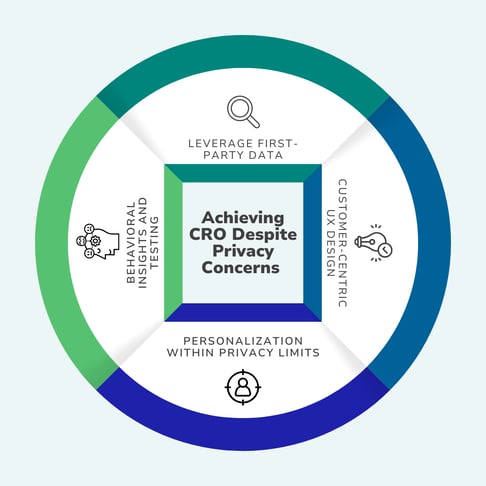Conversion Rate Optimization (CRO) is essential for businesses looking to maximize their marketing efforts and drive growth. It’s the tide that lifts all boats and often provides the highest ROI for your business. However, the increasing emphasis on data privacy is prompting companies to rethink their strategies with less data available. As new regulations emerge and consumers become more vigilant about how their data is used, businesses face the challenge of optimizing conversions while respecting user privacy.
The Growing Importance of Data Privacy
Data privacy has rapidly evolved from a niche concern to a mainstream priority. Regulations such as the General Data Protection Regulation (GDPR) and the California Consumer Privacy Act (CCPA) have set new standards for data handling and user consent. These regulations not only enforce stricter data protection measures but also empower consumers to control how their personal information is collected and used.
According to a study by Pew Research, over 79% of U.S. adults are concerned about how companies use their data. This shift in consumer sentiment is driving businesses to adopt more transparent data practices, ensuring compliance while maintaining customer trust and ultimately delivering exceptional customer experiences.
Challenges for CRO in a Privacy-Focused World
As data privacy regulations tighten, traditional CRO tactics face significant limitations. Key challenges include:
- Reduced Access to Data: Stricter regulations mean less access to third-party data, making it harder to track user behavior across multiple platforms.
- Diminished Effectiveness of Cookies: With many users opting out of cookie tracking, businesses must find alternative ways to gather actionable insights.
- Increased Need for Transparency: Companies must be upfront about data usage, requiring clear consent forms and easy opt-out options.
Data Security Measures Being Implemented
To address these challenges, businesses are adopting various data security measures:
- First-Party Data Strategies: Companies are increasingly relying on data collected directly from users through their own platforms. This approach not only ensures compliance but also builds a direct relationship with customers.
- Anonymization and Pseudonymization: These techniques help protect user identities while still allowing for valuable data analysis. By removing personally identifiable information (PII), businesses can mitigate privacy risks and still learn more about their users in a hashed proxy-based approach.
- Consent Management Platforms (CMPs): CMPs provide a centralized solution for obtaining and managing user consent, ensuring that companies comply with regulations and respect user preferences.
Best Practices for Achieving CRO Despite Privacy Concerns

Even in a privacy-focused environment, businesses can still achieve effective CRO by adopting best practices:
- Leverage First-Party Data: Utilize data collected directly from users through website interactions, surveys, and customer feedback. This approach not only respects privacy but also enhances the accuracy of insights. For an eCommerce business, this could also look like an account login. This provides the business with actionable insights on the user, and also feels native to the user that is incentivized to provide additional information so that the business can provide a better experience. A synergistic relationship will always win over transactional relationships in the long-term.
- Customer-Centric UX Design: Create user experiences that prioritize privacy, such as clear consent options and transparent data usage policies. A positive user experience builds trust, which can lead to higher conversions. Additionally, businesses can enhance trust by continuing to provide the most basic CRO practice of setting expectations for your user. A user should know exactly what happens next after they provide their information. Quick text such as “your information will only be used to contact you for our services. A sales representative will reach out to you within the next business day” help reassure your prospect and build trust in your brand.
- Behavioral Insights and Testing: Use behavioral analytics and A/B testing to understand user preferences and optimize website elements. Ensure that these tests comply with privacy regulations and do not infringe on user rights. User surveys, focus groups, and user testing are powerful first-party behavioral testing methods that can provide valuable insights to optimize your conversion funnel. Still skeptical? One of our clients used these strategies to drive over 1,500 additional orders and achieve a 20% year-over-year increase in revenue by leveraging user feedback to create personalized ad copy, page content, and creative strategies.
- Personalization within Privacy Limits: Personalization can still be achieved using anonymized data and customer segmentation. Extrapolated data points can be hashed and grouped to provide broader insights into a demographic/user-based that makes it easy to provide better customer experiences. Tailoring content and offers based on broad categories can enhance relevance without compromising privacy.
Conclusion
Balancing CRO with data privacy is not only possible but essential in 2024. By adopting privacy-first strategies, leveraging first-party data, and creating user-centric experiences, businesses can achieve their CRO goals while respecting user privacy. As data privacy continues to evolve, embracing these practices will ensure long-term success and customer loyalty.
Need help or want to talk about CRO strategy? Inquire about our Conversion Rate Optimization Services today.